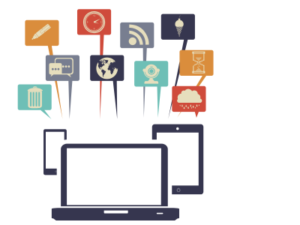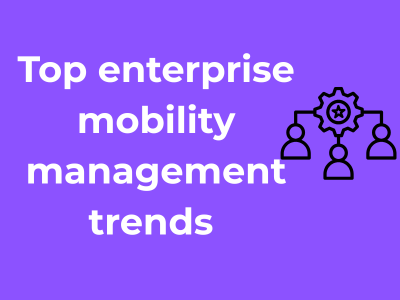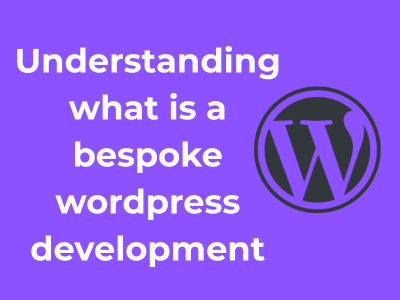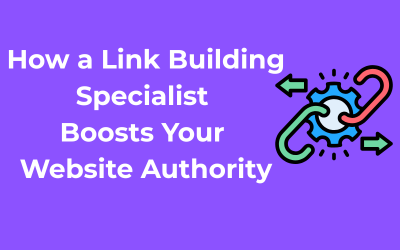Let’s face it, the way we work has changed dramatically. The traditional office environment has morphed into something much more flexible, and many businesses now rely on hybrid workforce models. This blend of in-office and remote work isn’t just a fleeting trend; it’s shaping the future of work! But like any major shift, it comes with its own set of challenges and benefits. Let’s break it down together.
Challenges of the Hybrid Workforce
The hybrid workforce may sound like a dream – a little bit of structure, sprinkled with the freedom of remote work – but it’s not without hurdles. Here are a few sticking points:
- Device Management: Employees use multiple devices, from phones and laptops to tablets and desktops, and managing them all can lead to headaches. Ensuring smooth synchronization, updates, and compatibility often feels like herding cats.
- Communication Gaps: With some employees in the office and others scattered across the globe, keeping everyone on the same page can be tricky. Tools like messaging apps and video calls help, but they aren’t always perfect.
- Security Risks: Hybrid work opens doors to new vulnerabilities. From unsecured home networks to increased risks of cyberattacks, IT teams have their work cut out for them.
- Employee Engagement: Maintaining team cohesion and a strong company culture when employees are spread thin? That’s no small feat!
Clearly, managing a hybrid workforce comes with complexities. But here’s the good news – there are also some incredible advantages that make navigating these challenges worthwhile and meet required production or services.
Advantages of the Hybrid Workforce
Once you iron out the kinks, embracing a hybrid workforce delivers a wealth of exciting benefits. Let’s take a closer look:
- Improved Work-Life Balance: Employees appreciate the ability to tailor their schedules and work environments, ultimately reducing stress and boosting productivity. A happy workforce is a successful workforce!
- Access to a Larger Talent Pool: Since location is no longer a barrier, companies can tap into talented individuals from across the world. This gives businesses an edge in hiring the best of the best.
- Cost Savings: With fewer employees in the office at any given time, organizations can reduce expenses related to office space, utilities, and supplies. Who doesn’t love saving money?
- Resilience and Continuity: Whether it’s a snowstorm or a global pandemic, hybrid work ensures your business can keep chugging along, come what may.
The rise of the hybrid workforce isn’t just about where people work; it’s about reshaping how we view work altogether. Sure, there are challenges to tackle – from managing security to fostering collaboration – but the positives far outweigh the negatives.
Ultimately, adopting a hybrid model is an investment in your people, your flexibility, and your long-term growth. The key to success is finding the right tools and strategies to make it work seamlessly for your unique organization. So, dive in with curiosity, embrace the change, and watch your business thrive!
Advanced Device Management Solutions Shaping the Industry

Alright, let’s dive into the fascinating world of device management! If your business is riding the tech wave (and honestly, who isn’t these days?), you know how important it is to manage all the devices floating around in your workforce. From smartphones and tablets to laptops, they’re everywhere — and the way we handle these devices is evolving fast, thanks to advanced device management solutions. Let’s explore why this matters and how it’s shaping the industry today.
Smart Management, Big Payoff
At its core, device management is all about control: making sure that every device in your organization is secure, up-to-date, and optimized for productivity. But advanced device management solutions take this to a whole new level. With tools like Mobile Device Management (MDM) or Enterprise Mobility Management (EMM), IT teams can manage thousands of devices remotely, saving both time and headaches.
Imagine deploying software updates or setting up security patches across your entire organization with just a few clicks. No need to wrestle with individual devices or worry about missing an update. It’s like having a magic wand for your tech ecosystem!
Benefits That Speak for Themselves
Now, let’s talk about why these advanced systems are a game-changer. Here are a few standout benefits your business should know about:
- Streamlined Device Setup and Configuration: Say goodbye to those long hours spent manually configuring devices. Tools like MDM allow IT teams to roll out a standardized setup to new devices automatically, ensuring consistency and saving time.
- Proactive Monitoring and Maintenance: With real-time dashboards and alerts, you’ll know instantly if a device is out of compliance, potentially infected with malware, or facing other issues.
- Centralized Policy Enforcement: Whether it’s blocking unauthorized apps, enforcing password policies, or encrypting data, you can implement organization-wide rules easily and efficiently.
- Enhanced User Experience: Not every trend must be complex! These solutions simplify the end-users’ lives too by giving them access to self-service portals, secure apps, and streamlined connectivity to the company network.
Rising Trends to Watch
So, what’s next for advanced device management? If we look at recent trends, the industry is definitely leaning into automation and intelligence. Here are two key directions to keep an eye on:
- Zero-Touch Enrollment: This is a hot topic right now. Essentially, devices are pre-configured before they even land in the user’s hands, so employees can just unbox them, power them on, and get straight to work. It’s almost magical!
- Cross-Platform Compatibility: Gone are the days when businesses relied on just one operating system. Advanced solutions are increasingly becoming OS-agnostic, allowing seamless management of iOS, Android, Windows, macOS, and even Linux devices.
Enhanced Security in Mobile Work Environments

Hello there! So, let’s talk about something really essential—security. Especially in today’s world where mobility in the workplace is not just an option but a necessity. Whether you’re stretching your legs at the coffee shop for a quick work session or reviewing a presentation on your tablet before a virtual meeting, securing your mobile workspace is of paramount importance.
Now, enterprise mobility has made work possible from almost anywhere on the planet. But here’s the thing: mobile work environments come with unique security challenges. No one wants sensitive business data to fall into the wrong hands, am I right? That’s why enhanced security in mobile work environments is the superhero trend we need. Let’s dive into how it’s shaping up and why it’s absolutely critical.
The Threat Landscape Is Real
It’s no secret—cyber attackers love hitting where it hurts. Mobile devices are especially vulnerable to threats like malware attacks, phishing schemes, and unauthorized access. The rise of remote work and BYOD (Bring Your Own Device) policies have only added layers of complexity to maintaining secure environments.
That’s where businesses need to step up their game. By implementing cutting-edge security solutions designed for mobile setups, companies can keep their digital environments airtight no matter where employees are working from.
Security Across Devices
Here’s the thing: effective mobile security is no longer just about locking down laptops or smartphones. It’s about ensuring every piece of hardware used for work is protected—even wearables and IoT devices that are becoming part of the workspace. Advanced solutions like Mobile Device Management (MDM) and Enterprise Mobility Management (EMM) now include security layers that prevent unauthorized access and ensure compliance with industry standards.
- App-Level Security: Apps used for business are getting robust protections, from encrypted messaging to secure file sharing. Employees can breathe easy knowing their apps are siloed and separated from personal data.
- Zero-Trust Architectures: Businesses are adopting zero-trust models, where no device or user is automatically trusted, even within a secured network.
- Remote Wiping Capabilities: Lost phone? No problem. Remote wipe features allow businesses to erase sensitive data in minutes!
Proactive Monitoring and Threat Detection
Modern work environments rely heavily on proactive monitoring. Tools powered by advanced analytics and artificial intelligence (AI) can identify unusual behavior as it happens. For example, if someone logs into the corporate CRM from an untrusted location, the system can immediately flag and block the attempt.
This kind of real-time threat detection is key to stopping breaches before they happen. Talk about peace of mind, right?
Striking the Balance: Security Without Compromising Usability
No one likes constantly entering passwords or jumping through hoops just to access work files. Thankfully, enhanced security doesn’t mean sacrificing user experience. Features like biometric authentication and single sign-on (SSO) combine convenience with robust protection.
Also, businesses are adopting secure VPNs (Virtual Private Networks) and even leveraging end-to-end encryption for both communication and data storage. It’s all about striking the right balance.
Why This Trend is Non-Negotiable
- Hybrid Work Is Here to Stay: Whether at home or the office, employees need secure access to tools and data to stay productive.
- Regulatory Compliance: From GDPR to HIPAA, staying compliant is a must to avoid hefty fines and penalties.
- Reputation Protection: Data breaches can erode customer trust. Investing in security safeguards your brand’s reputation.
And there you have it! Enhanced security in mobile work environments is no longer just an add-on; it’s an absolute must-have in modern businesses. As technology evolves, companies that embrace this trend will not only protect their assets but also empower their employees to work confidently from anywhere. Pretty great, right?
AI and Machine Learning in Mobility Management
Let’s talk about artificial intelligence (AI) and machine learning (ML) – the buzzwords that seem to be on everyone’s mind these days! These technologies aren’t just for self-driving cars or voice assistants; they’re playing a pivotal role in transforming enterprise mobility management (EMM) as well. With the increasing complexity of managing devices, apps, and data within organizations, AI and ML have stepped in as game-changers. Sit tight because we’re diving into how they’re reshaping mobility management in exciting ways!
Why AI and ML are a Perfect Fit for EMM
Managing mobile devices and ensuring seamless workflows across an organization isn’t as simple as flipping a switch. Thankfully, AI and ML are here to simplify the equation. These technologies analyze vast amounts of data, find patterns, and automate repetitive tasks – all while improving accuracy and efficiency.
- Smart Automation: Tired of manual updates or troubleshooting device problems? AI handles tasks like device setup, app deployments, and even predictive maintenance with zero micromanaging. This means your IT team can focus on other strategic priorities.
- Proactive Decision-Making: ML algorithms can predict potential issues or bottlenecks by spotting trends early. Imagine addressing a spike in app crashes before employees even notice – talk about being proactive!
- Customizing the Experience: Whether it’s personalizing the application setup for users or streamlining workflows, AI makes mobility in the workplace more intuitive and user-centric.
AI-Powered Security: The Backbone of Mobile Management
Let’s face it: mobile device security is a big deal for enterprises, especially in today’s remote and hybrid work setups. Here’s where AI flexes its muscles:
- Real-Time Threat Detection: AI gets smarter over time, learning to identify potential threats like unauthorized access or malicious software. The best part? It works in real time, so organizations can stay a step ahead of cyber threats.
- Dynamic Permissions: Forget static rules for accessing company resources. AI continuously evaluates behavior, ensuring only authorized users access sensitive information – no more one-size-fits-all security protocols!
Faster Troubleshooting with AI Assistance
Ever called tech support only to spend ages solving a simple issue? With AI taking charge within mobility management systems, troubleshooting has gotten a whole lot faster. AI-powered chatbots and virtual assistants can provide employees with instant help, guiding them through a fix or routing the problem to the right technician. Say goodbye to long wait times and hello to lightning-fast resolutions.
The Future Looks Bright
This is just the beginning of what AI and ML can do for enterprise mobility management. As these technologies keep evolving, expect features like predictive analytics and voice-powered interfaces to become the norm, making device management even more seamless and intelligent. One thing’s certain: embracing these innovations now can give your organization the competitive edge it needs in an increasingly mobile workforce.
So, are you as excited about AI-driven mobility management as we are? Keep an eye on this trend because it’s not just a passing fad – it’s the future of smarter, more effective enterprise management.
Cloud Integration and Scalability for Business Growth
Hey there! Let’s talk about something super important for businesses in today’s world: cloud integration and scalability. These two concepts might sound a bit techy, but trust me, they’re absolute game-changers for enterprise mobility management (EMM). And here’s why—they unlock the power to grow, adapt, and innovate in a fast-paced, ever-changing market. Let’s break it down and discuss why this is such an exciting trend.
Why Cloud Integration is a Must-Have
You’ve probably noticed that most businesses are leaning heavily into cloud-based services. There’s a good reason for that. Cloud integration allows companies to connect their devices, applications, and systems seamlessly. Think of it as creating a central hub where everything a business needs to work efficiently comes together. For mobility management, this is a big win.
- Anywhere Access: With cloud integration, employees can access their work tools and data from anywhere, at any time, and on any device. This flexibility becomes a great asset, especially for remote and hybrid teams.
- Easy Updates: No more worrying about manually updating devices or software. Everything can be done from the cloud, staying current with minimal downtime.
- Collaboration Boost: The cloud fosters collaboration, allowing employees to work together seamlessly using shared tools and platforms, regardless of location.
All of this means fewer tech headaches and a lot more productivity. Does that sound good so far? Let’s dive into scalability because that’s where the magic happens.
Scalability: The Secret to Staying Ahead
Scalability isn’t just a trendy buzzword—it’s what helps businesses adapt to growth without missing a beat. Imagine this: you work at a business that suddenly hits it big, and there’s a demand for your services or products like never before. What do you do? You scale up seamlessly, thanks to your cloud-powered mobility solutions. That’s the promise of scalability!
- Adapt to Growth: Need more storage? Add it. Got new employees coming on board? Provision their devices in minutes. As businesses grow, the cloud effortlessly accommodates it.
- Cost-Effective Scaling: You pay for what you need. No bulky infrastructure investments that outgrow their usefulness in a few years.
- Agile Expansion: In today’s competitive market, agility is key. Scalability ensures that you can expand your fleet of devices and services without breaking a sweat (or the bank).
Adding the Wow Factor
Here’s something cool: cloud integration doesn’t just help with the tech side of things; it also empowers innovation. Businesses can integrate with other cutting-edge technologies like AI and IoT (Internet of Things) to further enhance their operations. Imagine a world where your devices and systems aren’t just connected but intelligently working together to streamline your workflows. It’s not science fiction—it’s the power of the cloud!
Cost Efficiency Through Comprehensive Management Tools
Let’s talk about everyone’s favorite topic—saving money! Okay, maybe it’s not the most exciting topic, but when it comes to enterprise mobility management (EMM), reducing unnecessary costs while boosting efficiency is a huge win. Comprehensive management tools are rapidly becoming the secret weapons for businesses aiming to do more with less, without compromising on productivity or security. Let’s dive into what these tools bring to the table and how they can streamline your business operations.
What Are Comprehensive Management Tools?
Before we get granular, let’s define what we’re talking about here. Comprehensive management tools are all-in-one software solutions designed to manage mobile devices, apps, data, and security. Think of them as the Swiss Army knives of enterprise mobility. Instead of juggling multiple software applications for different management tasks, these tools integrate various functionalities into a single dashboard. Convenient, right?
Why Cost Efficiency Matters in EMM
It’s no secret that running a business entails costs—sometimes more than we’d like. Enthusiastically adopting EMM without a cost-efficient strategy can lead to expensive mistakes, like duplicated software or mismanaged device lifecycles. Here’s where comprehensive tools step in to keep your wallet intact.
Where Comprehensive Tools Deliver Savings
Now let’s break down the ways these tools help you stretch your budget while keeping your workforce productive:
- Unified Solutions Save Licensing Costs: Managing mobile devices and security with different tools often means paying for multiple subscriptions. Consolidated tools reduce the need for overlapping software, cutting down on licensing expenses. It’s like buying a combo meal instead of ordering separate items—it just makes sense.
- Streamlined Management Saves Time: Time is money, and comprehensive management tools simplify workflows by offering a centralized platform where admins can monitor everything from one place. Whether it’s deploying updates, managing apps, or handling security protocols, it’s a smoother, faster ride.
- Data Waste Reduction: Ever heard of data sprawl? It’s what happens when your team ends up with redundant data across platforms—leading to more storage costs on the cloud or elsewhere. Comprehensive management tools aid in organizing and cleaning up unnecessary data clutter.
- Longer Device Lifecycles: By using real-time monitoring and proactive troubleshooting features, these tools help you avoid problems that might shorten device lifespans. Fewer broken devices mean fewer replacements and repairs.
Building a Customizable and Scalable Framework
Another way these tools drive cost efficiency is through scalability. Whether your business is a small startup or an industry giant, scalable enterprise mobility solutions grow alongside you. Instead of investing in brand-new infrastructure every time your company expands, you can easily add users, devices, and apps to the existing setup. This “pay-as-you-grow” model ensures you’re not overspending when starting small or underprepared when scaling up.
The ROI of Better Resource Allocation
Finally, comprehensive management tools help allocate resources where they’re needed the most. Automated tracking of resource usage provides insights into areas where costs can be trimmed or optimized. For example, underutilized apps can be identified and retired, freeing up funds for more effective technologies.
Making the Transition Wisely
Cost efficiency doesn’t just mean spending less; it means spending smarter. If you’re considering adopting a comprehensive EMM solution, take the time to evaluate what your business needs. Perform cost analyses, assess which tools add value to your unique workflows, and test solutions through trial periods before diving in fully.
So, there you have it—managing mobility while managing costs! With the right comprehensive tools, you not only achieve significant savings but also gain peace of mind knowing your resources are being used thoughtfully. And who wouldn’t want that?
Personalization in Enterprise Apps for Productivity Boost
Ever feel like work apps just throw you into a one-size-fits-all system without considering your unique needs or workflow? You’re not alone! Personalization in enterprise applications is no longer a nice-to-have; it’s a must-have for boosting productivity and enhancing user satisfaction. Let’s dive into why personalization is such a game-changer for businesses today.
1. Tailored Experiences Lead to Better Adoption
When enterprise apps are tailored to the specific needs of employees, adoption rates typically skyrocket. Why? Because no one wants to wrestle with unnecessary features or an overly complicated interface! Personalized apps allow users to interact with tools and layouts that are relevant to their roles, making day-to-day operations smoother and more intuitive.
Pro Tip: Find apps or platforms that let employees customize dashboards, prioritize tasks, or display information based on their personal preferences for ultimate usability.
2. Enhanced User Satisfaction
Imagine logging into an app and being greeted with functionalities and options that feel like they were made for you. A personalized experience fosters satisfaction and a sense of ownership, which can inspire employees to engage more with the platforms they use daily. Happy employees = better work outcomes, right?
3. Role-Based Features for Better Efficiency
Not every worker has the same job, so why should they all have access to the same generic tools in their app? Role-specific personalizations ensure that managers, field workers, customer service agents, and IT teams each have what they need, without being overwhelmed by irrelevant features. This reduction of “clutter” streamlines operations across the board.
A personalized app might, for example:
- Give managers real-time analytics on team performance.
- Show field workers their schedules and geo-location data.
- Offer customer service reps auto-populated scripts for client calls.
Think about how much time and frustration that could save!
4. Productivity Gains from Intelligent Insights
Smart enterprise apps now incorporate analytics to observe user habits and recommend efficient workflows or tools based on historical data. Personalization at this level allows employees to make real-time decisions with confidence. For instance, some platforms can analyze your tasks and suggest automations or shortcuts tailored to your job habits—how cool is that?
5. Support for Flexible Work Environments
With the rise of hybrid work, personalization becomes critical for optimizing flexible work environments. For remote employees, tailored enterprise apps can ensure they sync with vital corporate resources and remain productive, whether they’re working from the office, co-working spaces, or their home desks. Firms that implement such tech often report improved alignment between distributed teams!
Steps to Implement Personalized Enterprise Applications
It’s not hard to get started enhancing your apps for personalization. Here’s a quick action list:
- Identify roles: Define the key user groups in your company and their specific needs.
- Choose the right vendors: Look for EMM solutions that offer robust customization tools and ongoing support.
- Enable user feedback: Allow end-users to share what’s working and what’s not, so the experience can be continuously refined.
- Utilize AI: Leverage platforms that integrate machine learning to deliver smarter, personalized features over time.
The Future is Personalized
Personalization in enterprise mobility management isn’t just a passing trend—it’s here to revolutionize the way we work. By prioritizing user-specific tools and intelligent workflows, businesses can significantly boost productivity while fostering happier, more engaged employees. As technology continues to evolve, don’t be surprised if personalization becomes the standard benchmark for enterprise-grade applications.











